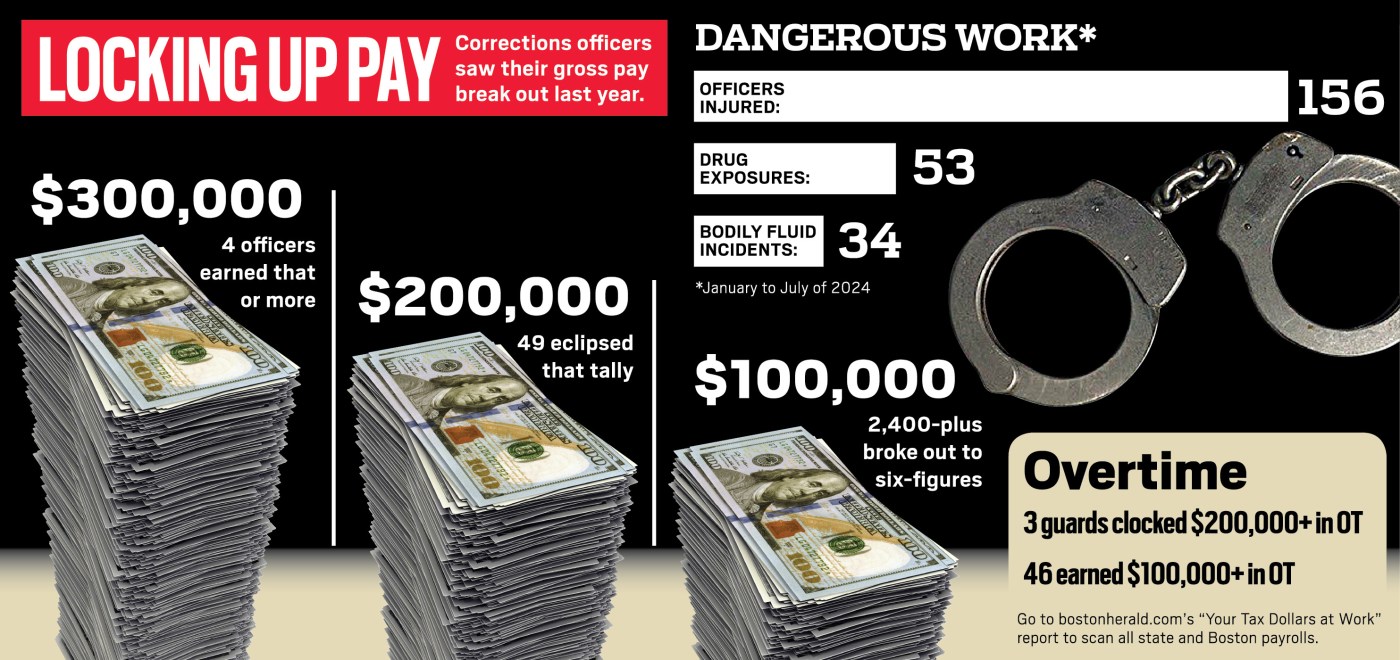
Study shows the Bay State spends more than any other on its prisoners
Massachusetts continues to spend more putting and keeping people behind bars than any other state, according to a recent study.
While the Bay State can boast the lowest incarceration rate among the 50 states, it spends more than twice per prisoner as Vermont, the second highest spending jurisdiction, according to a recent study published by the law firm Bader Scott.
The law firm’s study matches findings published by government data aggregator USAFacts in 2024, and in both publications, the Bay State is listed as spending $307,468 per prisoner.
Vermont, which the study shows spends around $134,000 per inmate, came in at number two, while the lowest-spending Arkansas, was found to shell out just $23,000 per confined person.
According to Seth Bader, the law firm’s founder, a state’s investment in correction directly correlates to its results.
“These financial decisions impact everything from rehabilitation programs to recidivism rates. States that invest more per prisoner often provide better educational opportunities and mental health services, which can reduce the likelihood of reoffending after release,” Bader said.
The study examined data from the U.S. Census Bureau’s Annual Survey of State and Local Government Finances against prison population data provided by the Bureau of Justice Statistics to arrive at the cost borne by each state’s Department of Corrections equivalent and other state-level “criminal justice agencies.”
The study found that, overall, states that spend less per prisoner tend to have far more people behind bars, according to Bader.
“Our research also highlights that states with lower per-prisoner spending typically have higher incarceration rates. This raises important questions about the relationship between adequate funding and effective criminal justice outcomes. The unprecedented spending variations across states will likely prompt policymakers to examine how prison budgets are allocated. The median state expenditure per prisoner stands at $64,865, yet 29 states fall below this figure,” he said.
The study also examined the worldwide prison population, finding that the U.S. continues to confine the most people. China, which claims about four times the U.S. population, has imprisoned around 1.69 million people, while there are approximately 1.76 million people incarcerated across the 50 states.
Keeping prisoners within one of its Department of Correction facilities accounts for a large chunk of the money spent per prisoner in Massachusetts — covering everything from housing, healthcare needs, substance use treatments, educational programming, food, clothing, toiletries, and administrative expenses — while the rest of the cost is spread among the state’s various criminal justice adjacent agencies, according to the study.
Using figures from 2021, when the DOC’s budget of $720 million is divided by the roughly 6,600 confined people in Massachusetts that year, the cost comes out to about $107,000 per person. However, there are other costs associated with keeping a person in a DOC facility that push the price tag higher, according to department spokesman Scott Croteau.
“The Massachusetts Department of Correction invests approximately $131,000 per incarcerated individual each year to uphold its mission of maintaining a safe, secure and rehabilitative environment,” Croteau said.
This investment, Croteau said, is a reflection of the state agency’s “deep commitment to addressing the complex healthcare needs of the 6,000 individuals in our care while providing the education, job training and substance use treatment to support successful reintegration.”
According to information provided by the DoC, in 2019 the recidivism rate for Massachusetts prisoners within three years of release was 26%. Compare that to data out of Delaware, where in 2018 about 56% of prisoners had returned to state custody within three years of release.
“As a national leader in reducing recidivism and incarceration rates, Massachusetts leverages evidence-based programs and strategic resource management to promote rehabilitation, accountability and post-incarceration success,” Croteau said.
Beyond the state’s desire to truly reform its prisoners, the Bay State’s corrections costs are also buoyed by the same forces that make everything else in the state expensive — high housing prices, maintenance of old facilities, and a relatively high cost of living.
While the Bureau of Labor Statistics shows that the median salary for a corrections officer is just shy of $59,000 annually, prison guards in Massachusetts are among the highest paid in the nation and made a median salary of $77,260 in 2023. Last year, at least four officers worked enough overtime to earn more than $300,000, and another 49 clocked the hours to earn more than $200,000.
Apart from those high overtime earners, a corrections officer’s salary is generally not a lot to live on in the Bay State, where the median cost of living breaks into six figures. Working with prisoners is also a dangerous line of work. From January to July of last year alone, 156 officers were injured on the job, 53 were exposed to dangerous drugs, and 34 were pelted with bodily fluids.
Peter Brown, a spokesman for the Massachusetts Correction Officers Federated Union, said the Bay State’s corrections officers are “in favor of” spending on “education programs and mental health services,” but that there are other areas of the system that could use some monetary attention.
“We ask that the Department of Correction keep its focus on the safety inside the prisons,” he added, especially due to “an increase over the last few years in illicit drug use and assaults on our officers with deadly weapons.”


